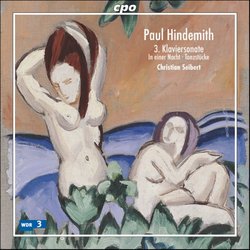| All Artists: Paul Hindemith, Christian Seibert Title: Hindemith: Piano Works Members Wishing: 0 Total Copies: 0 Label: Cpo Records Original Release Date: 1/1/2007 Re-Release Date: 3/27/2007 Genres: Dance & Electronic, Classical Styles: Chamber Music, Forms & Genres, Sonatas, Historical Periods, Classical (c.1770-1830), Modern, 20th, & 21st Century, Instruments, Keyboard Number of Discs: 1 SwapaCD Credits: 1 UPC: 761203717125 |
Search - Paul Hindemith, Christian Seibert :: Hindemith: Piano Works
 | Paul Hindemith, Christian Seibert Hindemith: Piano Works Genres: Dance & Electronic, Classical |
Larger Image |
CD Details |
CD ReviewsChromatic, Contrapuntal, Neoclassic, Dancing Middle-Period H J Scott Morrison | Middlebury VT, USA | 05/10/2007 (4 out of 5 stars) "Hindemith was not much of a pianist -- he was a professional violist -- but you would never know it from his piano music. It lies fairly well under the hands and he has written at least two twentieth-century classics for piano: the Third Sonata Hindemith: The 3 Piano Sonatas, and Ludus Tonalis Hindemith: Ludus Tonalis; Suite '1922'. Here we have a fair helping of his piano music played by a young German pianist, Christian Seibert, previously not known by me. He has a clean, urgent, technically assured style of playing which fits Hindemith's lean and contrapuntal works like a glove. Unfortunately the big piece here, the Third Piano Sonata, has massive competition from the classic recording made by Glenn Gould. Having studied the score I would venture the opinion that Seibert probably stays closer to Hindemith's instructions about how to play the piece. Still, the Gould recording has attained such legendary status that one can hardly argue with it or its proponents of which I am, I admit, one. Seibert tends to downplay the siciliano aspects of the first movement while emphasizing the drama. Gould's counterpoint is, no surprise, the more satisfying partly because of his somewhat drier style. The second movement, a duple-meter piece that is a scherzo in all but name, is done beautifully here with clearly delineated accents and tempo dislocations. The third movement begins like one of those trudging and harmonically rich movements found in Hindemith's orchestral works (Symphonic Metamorphoses; Mathis der Maler, say) until it breaks into a playful Hindemithian free fugato. Nicely done here. The finale continues in fugal style and one is reminded, dare I say, of the late Beethoven sonata fugues in all but harmonic style which is, of course, Hindemith's own. Gould's playing here is, for me, the more exciting; Seibert's playing is a bit cool and even seems a bit under-involved.
The other works here are new to me. The Dance Pieces are lively and rhythmically inventive. I particularly like the Third Piece which is like one of Schumann's Kinderszenen on LSD. Seibert appropriately points up the dance rhythms of these pieces and I suspect that even staunchly conservative musiclovers might find themselves tapping their toes. More ambitious are the fourteen characteristic pieces of 'In einer Nacht' ('In a Night') which starts with the extraordinarily effective 'Müdigkeiten' ('Wearinesses'), which inhabits the same emotional world as the Nachtmusik movements of Mahler's Seventh Symphony. How's this for the title of the third piece: 'Phantastisches Duett zweier Bäume vor dem Fenster' ('Fantastic Duet of Two Trees at the Window')? Shades of the fanciful titles of Erik Satie or Rued Langgaard! It is basically a two-part invention with high and low lines moving towards and away from each other in Hindemith's characteristic contrapuntal language. And it is followed by 'Rufen in die horchende Nacht' ('Shouting into the Listening Night'), a kind of dream (or nightmare) piece. No. 9 is a grotesque duet between 'Owl and Cuckoo' with the owl calling 'kookoo' and the cuckoo 'hoot hoot'! In No. 12, 'Böser Traum' ('Bad Dream'), parodizes (in a somnolent tempo) a dance tune from Rigoletto. Don't ask me why! No. 13 is a '20s 'Foxtrott' (actually it sounds more like a rag). The set concludes with a 'Doppelfuge' ('Double Fugue') that could have been taken out of his 'Ludus Tonalis.' I don't quite know why, but I love Hindemithian counterpoint -- on the page, harmonically it doesn't make sense to me, but listening to it is always satisfying and unfailingly brings a smile to my face. I've given this CD four stars largely because I still prefer Gould's Third Sonata and for those who are looking for a single recording of that sonata I would recommend they go for the Gould (sorry, I couldn't resist!). Scott Morrison" |
